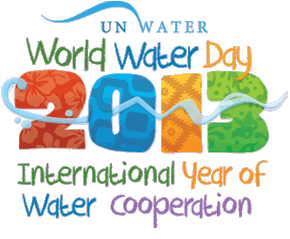
Recently, I attended a conference on the theme of environmental conservation and sustainability, and during the questions
and discussion at the end of the presentations someone stated that ‘soil is the most
important thing!’ I thought: no, water has got to be the most important thing,
since without water there’s no life – look at the planet Mars, lots of soil, but no water
and no life!
Water is essential for life and it is an important resource to
virtually all economic activities, including food production, energy and
industrial outputs. Clean water is an indispensable natural resource for a
healthy life for humans and for freshwater ecosystems and, therefore, demands
careful management. A growing world population and climate
change are adding pressure to already scarce water resources.
Today, 22nd March, is UN World Water Day,
which has been celebrated since 1993 and has become one of the key dates in
the UN calendar. Each year, WWD highlights a specific aspect of
freshwater. In 2013, in reflection of the International Year of Water
Cooperation, WWD is also dedicated to the theme of cooperation around
water and is coordinated by UNESCO in collaboration with UNECE and
UNDESA on behalf of UN-Water.
As an editor of the CABI internet resource Environmental Impact, I come across the latest publications on environmental issues, including reports from various prominent organisations and I have highlighted three on the subject of water below.
To celebrate the 20th anniversary of WWD, this week the Worldwatch Institute has highlighted seven strategies for reducing water wastage in the food system: 1.
Eating Less Meat (meat production uses much more water than plant-based
foods); 2. Using intercropping, agroforestry and cover crops to
conserve water; 3. Implementing micro-irrigation (approximately 60% of
water used for irrigation is wasted and drip irrigation is more
expensive to install but it is up to 40% more efficient, carrying water
or fertilizers directly to plants’ roots); 4. Improving rainwater harvesting (since the 1980s, according to the International Food Policy
Research Institute, farmers in Burkina Faso have been modifying
traditional planting pits to make them deeper and wider and adding
organic materials and, as a result, the pits retain rainwater for
longer, helping farmers to increase yields even in years of low
rainfall); 5. Using mobile technology to save water (the Indian
entrepreneur Santosh Ostwal has developed a system that allows farmers
to use mobile phones to turn their irrigation systems on and off
remotely, which helps reduce the amount of water and electricity wasted
on watering fields that are already saturated); 6. Planting perennial
crops because these crops protect the soil for a greater length of
time than annual crops, which reduces water loss from runoff;
7. Practicing soil conservation, for example some techniques, including no-till
farming, can help farmers to better utilize the water they have
available. These strategies are described in the Food Tank website.
The Regional Policy Dialog on Water and Climate Change in the Americas produced a publication entitled Water and Climate Change Adaptation in the Americas: Solutions from the Regional Policy Dialog (RPD). The
report comprises 5 chapters: Ch 1 describes the climate services
infrastructure and information for adaptation to climate change in the
Americas; Ch 2 discusses the role of ecosystem services in the adaptive
management of water resources; Ch 3 is about integrated water resources
management; Ch 4 describes water-based adaptation to climate change in
cities; and Ch 5 discusses society participation in knowledge sharing,
equity and poverty reduction to face the challenge of water based
climate change adaptation. The report states that water resources are
the medium through which climate change directly impacts food security,
health, energy generation, development planning and the protection of
ecosystems and biodiversity, but that at the same time, water is
critical for climate change mitigation, as many efforts to reduce carbon
emissions rely on water availability. The document presents practical
solutions to problems, for example: to reduce risk from drought and
wildfire and protect water resources in the city of Santa Fe, New
Mexico, USA, a few forest restoration strategies have been implemented,
such as the mechanical thinning of small-diameter trees, controlled
burns to reintroduce low-severity ground fires that historically
maintained forest health, and comprehensive monitoring to determine
effects of these treatments on forest and stream habitats, plants,
animals and soils. This project secures water for city users and is
supported by a strong local science-management partnership.
A briefing note published by the Global Water Partnership earlier this week stated that
“Water is central to the world’s development challenges. Whether it is
food security, poverty reduction, economic growth, energy production, or
human health – water is the common denominator and climate change is
the spoiler. The increase in catastrophic events such as droughts and
floods will impact lives, livelihoods, land values, and investment
incentives, especially in vulnerable areas inhabited by poorer
populations.” Link to the briefing note.
The UN Water website has a form for the public to register events being
held to mark the day. There are already over 450 events on the world map of events! Enter your events as well in order to be featured on the website, or search for events taking place near you!
Link to the WWD newsletter.
Related articles



